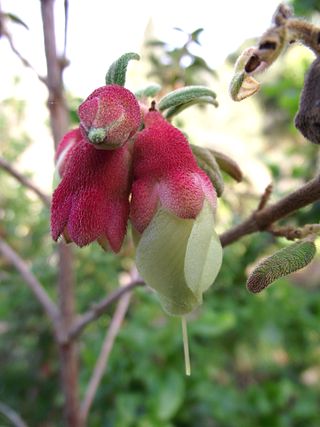
Melastomataceae is a family of dicotyledonous flowering plants found mostly in the tropics comprising c. 175 genera and c. 5115 known species. Melastomes are annual or perennial herbs, shrubs, or small trees.

Tibouchina is a neotropical flowering plant genus in the family Melastomataceae. Species of this genus are subshrubs, shrubs or small trees and typically have purple flowers. They are native to Mexico, the Caribbean, and South America where they are found as far south as northern Argentina. Members of this genus are known as glory bushes, glory trees or princess flowers. The name Tibouchina is adapted from a Guianan indigenous name for a member of this genus. A systematic study in 2013 showed that as then circumscribed the genus was paraphyletic, and in 2019 the genus was split into a more narrowly circumscribed Tibouchina, two re-established genera Pleroma and Chaetogastra, and a new genus, Andesanthus.

Monochaetum is a neotropical genus of shrubs and subshrubs with about 54 species. It occurs in warm temperate to tropical montane habitats from Mexico and Central America to the South American Andes of Colombia, Venezuela, Ecuador and Peru with one species reaching the Guayana Highlands of Venezuela and Guyana.

Brachyotum is a genus of flowering plants in the family Melastomataceae. There are about 58 species native to the Andes of South America.
Henriettea is a genus of flowering plants in the family Melastomataceae, with some 399 species accepted. It is distributed in the Americas. Some species in the genus are known commonly as camasey., though the common name camasey may also refer to plants of genus Miconia.
Chaetogastra anderssonii, synonym Tibouchina anderssonii, is a species of plant in the family Melastomataceae. It is endemic to Ecuador.
Chaetogastra campii, synonym Tibouchina campii, is a species of plant in the family Melastomataceae. It is native to Ecuador.
Andesanthus gleasonianus, synonym Tibouchina gleasoniana, is a species of plant in the family Melastomataceae. It is native to Colombia and Ecuador.
Chaetogastra oroensis, synonym Tibouchina oroensis, is a species of plant in the family Melastomataceae. It is endemic to Ecuador.

Chaetogastra grossa, synonym Tibouchina grossa, is a species in the Melastomataceae family that is native to Colombia, Ecuador and Venezuela. It is found between 2400 and 3800 meters in elevation. Also called "red princess flower" or "carmine princess flower" to differentiate it from "princess flower" which has purple blooms.

Microlicia is a genus of flowering plants in the family Melastomataceae, native to northern South America, particularly Brazil. They tend to be subshrubs.

Acisanthera is a genus of flowering plants in the family Melastomataceae. It contains 11 species and is found in South America, Central America, and the Caribbean. It was described by Patrick Browne in 1756.
Comolia is a genus of flowering plants belonging to the family Melastomataceae.

Huberia is a genus of flowering plants belonging to the family Melastomataceae.

Pleroma is a genus of flowering plant in the family Melastomataceae, native from Puerto Rico and the Leeward Islands to tropical South America.

Andesanthus is a genus of flowering plant in the family Melastomataceae, native to Colombia, Costa Rica, Ecuador, Panama, Peru and Venezuela. The genus was established in 2019 for some species formerly placed in Tibouchina. Some species are cultivated as ornamental shrubs or trees.

Chaetogastra herbacea, synonym Tibouchina herbacea, is a species of flowering plant in the family Melastomataceae, native to southern Brazil and north-eastern Argentina. It has been introduced to Hawaii. It was first described, as Arthrostemma herbaceum, by Augustin de Candolle in 1828.

Pleroma francavillanum is a species of flowering plant in the family Melastomataceae, native to Brazil. It was first described by Alfred Cogniaux in 1885 as Tibouchina francavillana.

Chaetogastra versicolor is a species of flowering plant in the family Melastomataceae, native to Brazil. It was first described by John Lindley in 1827 as Rhexia versicolor. One of its synonyms is Tibouchina versicolor.













